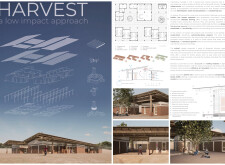5 key facts about this project
## Overview
The HARVEST project is an architectural initiative designed for the Casamance region of Senegal, focusing on sustainability and community enhancement. This project aims to meet both the physical and socio-economic needs of the locality by implementing a low-impact design philosophy that centers on environmental stewardship and community engagement.
## Spatial Organization
The architectural layout features a series of interconnected volumes surrounding a central courtyard, facilitating natural airflow and creating a nucleus for social interaction among students and community members. Multiple functional spaces including classrooms, counseling offices, a canteen, and multipurpose areas promote adaptability for various educational activities while enhancing the overall community spirit. The spatial arrangement encourages inclusivity, aligned with the cultural dynamics of the region.
## Material Selection and Sustainability
The project utilizes locally-sourced materials to minimize its ecological footprint. Bamboo serves as both structural and roofing material, providing lightweight durability and cultural relevance. Stabilized Compressed Earth Blocks (CEB), crafted from local laterite soil, contribute to thermal comfort and sustainability. Additionally, strategically placed stabilized concrete supports ensure structural integrity while indigenous wood elements enhance the design's contextual connection. The project incorporates rainwater harvesting systems and effective ventilation to promote an environmentally friendly operation, aligning with sustainable practices and fostering local economic resilience.



















































